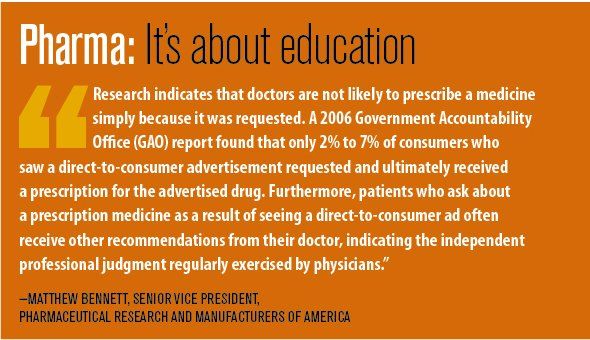Article
Strategies for primary care physicians to handle prescription medication requests
While direct-to-consumer advertising of prescription medications means patients are coming to the doctor with drug-related requests, some see an opportunity to educate.
The influx of new patients under the Affordable Care Act (ACA) may exacerbate an ongoing challenge for physicians: Responding to patient inquiries and requests for prescriptions in the wake of large-scale, direct-to-consumer pharmaceutical advertising campaigns. Physician experts say there are strategies practices can use to talk with patients about medication choices.
On one side of the direct-to-consumer advertising debate are doctors, who can be overwhelmed by patient demands for specific medications while trying to communicate effectively with a patient during a short encounter. On the other side is the pharmaceutical industry trying to educate patients, build awareness, and drive sales in a tightly-regulated and competitve industry.
Since 1997, when the U.S. Food and Drug Administration issued guidance to enable pharmaceutical companies to more easily advertise to the public on television, companies have spent billions annually on these consumer marketing efforts. As a November 2013 article in the American Medical Association Journal of Ethics concluded: “Drug advertisements remain pervasive and therefore exert an undeniable influence on the way the public learns about available therapies and how patients and physicians communicate.”
One-third of individuals who see a direct-to-consumer television ad, if it’s relevant to their condition, will ask doctors to prescribe that drug, and more than one-half of physicians will prescribe it, according to a national survey by USA Today, the Kaiser Family Foundation and the Harvard School of Public Health published in 2008.
“It’s much easier to write [the prescription] instead of spending five minutes explaining why a different drug is better than what’s on the market,” says Jeffrey Lobosky, MD, an associate clinical professor in the department of neurological surgery at the University of California-San Francisco.
Molly Cooke, MD, immediate past president of the American College of Physicians, says that while advertising is described as patient education, “the commitment to education” is not uniform across medications. For example, she says there is not much emphasis on common drugs. Instead, the companies stress newer, more expensive drugs still covered by patents. “This is a genie that’s notgoing to get put back in the bottle,” Cooke says
.

Next: Medication requests are an opportunity to educate your patients
ACA impact
The ACA likely will bring new patients into practices who haven’t been getting care, and medication questions related to advertising may become more frequent as physicians begin treating these patients. Physicians need to ensure that these medication inquiries are not a distraction from more critical topics.
“It’s more how you manage your time. Time is valuable in an office in terms of a patient’s face-to-face with the doctor,” says Wanda Filer, MD, FAAFP, a director of the American Academy of Family Physicians.
Cooke says doctors are going to have to learn how to organize teams so that other members of their staffs can start these conversations with patients.
An opportunity for education
A patient mentioning medication advertising is an opportunity that not enough physicians take advantage of, says Katherine C. Chretien, MD, FACP, associate professor of medicine at George Washington University in Washington, D.C.
She says these mentions are a sign that patients want to take charge of their own health and be empowered, regardless of whether the suggested treatment is the right one.
Chretien says physicians should keep an open mind. It could be a wrong treatment, but the patient is providing an opportunity for the doctor to talk about correct courses of action. It should be approached as an opportunity for shared decision-making with the patient, and a chance to strengthen their relationship.
“I know it’s an opportunity but I don’t think physicians handle it that way,” Chretien says.
The challenge is that answering these inquires takes time-the most precious resource the patient has when he or she is in your practice, says the ACP’s Cooke. Spending five minutes of a 15-minute patient encounter explaining why a new weight loss medication may not be right for them “is five minutes I can’t spend on something else.”
Her favorite example of how to deal with the situation concerns oral medications for toenail fungus in cases that are not related to vascular problems stemming from diabetes.
Typically, a patient will come in with an ad. Cooke likes to look up the medication online and go over the data with the patient. She points out how the medicine has to be taken for six months and only 27% of patients were cured compared with 19% cured by a placebo. In other words, three-quarters of patients who take the medicine still have a toenail fungus six months later. The medicine can potentially harm the liver and is expensive.
“Patients will often self-correct if you let them look at primary data in a form they understand,” she says. “Marketing makes them think it’s a cure all. The process is a bit time consuming but it’s my opportunity to end up with a happy patient.”
If Cooke doesn’t have time to conclude the conversation with a patient, she will point the patient to a website or another resource, and schedule the patient for a follow-up visit.





